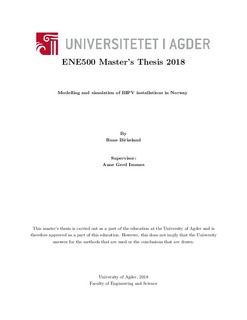| dc.contributor.author | Birkeland, Rune | |
| dc.date.accessioned | 2018-09-17T12:58:32Z | |
| dc.date.available | 2018-09-17T12:58:32Z | |
| dc.date.issued | 2018 | |
| dc.identifier.uri | http://hdl.handle.net/11250/2562991 | |
| dc.description | Master's thesis Renewable Energy ENE500 - University of Agder 2018 | nb_NO |
| dc.description.abstract | In this thesis, three BIPV-installations has been simulated, the simulated results of each system
have been compared to actual production for the real system. The parameters which are assessed
in this thesis are production, performance ratio and di erent system losses. The
BIPV-installations which are simulated, are Skarpnes, Solsmaragden and Brynseng located in
Arendal, Drammen and Oslo respectively. The simulations are done by obtaining weather data,
such as global horizontal irradiance and temperature. The weather data was retrieved in di erent
ways. PVsyst was used to generate synthetic data, real measured data on site was used and
weather stations located in close proximity was also used. A hypothesis has been carried out in
this thesis, regarding facade installations are more bene cial for northern latitudes, compared to
southern latitudes. This thesis simulated the same photovoltaic system mounted on the rooftop
and on the facade. Installation located in northern latitudes had more similar production for
facade compared to rooftop installations than installations for southern latitudes. South oriented
facade installations are more productive compared to other orientations. The results of this thesis
are in compliance with the literature for this professional area.
The simulations estimated a production deviation within a range of 0.24% - 10.69%. Performance
results showed values within the range of 65.2% - 81.5%. Losses with regard to these deviations
were examined and irregularities in irradiation on-site measuring and shading showed most
critical for the installations. Due to huge losses with regards to shading, a partial shading model
was used to illustrate the losses for the Brynseng installation. The thesis found the performance
of the systems as expected, however the Brynseng system being an installation with improvement
potential.
The simulations display deviation in production and discovers issues regarding losses for the
chosen systems. This information may be used to achieve more accurate evaluation and
understanding of BIPV systems located in Norway. | nb_NO |
| dc.language.iso | eng | nb_NO |
| dc.publisher | Universitetet i Agder ; University of Agder | nb_NO |
| dc.rights | Attribution-NonCommercial-NoDerivatives 4.0 Internasjonal | * |
| dc.rights.uri | http://creativecommons.org/licenses/by-nc-nd/4.0/deed.no | * |
| dc.subject | ENE500 | nb_NO |
| dc.title | Modelling and simulation of BIPV installations in Norway | nb_NO |
| dc.type | Master thesis | nb_NO |
| dc.subject.nsi | VDP::Teknologi: 500::Elektrotekniske fag: 540 | nb_NO |
| dc.source.pagenumber | 109 p. | nb_NO |

